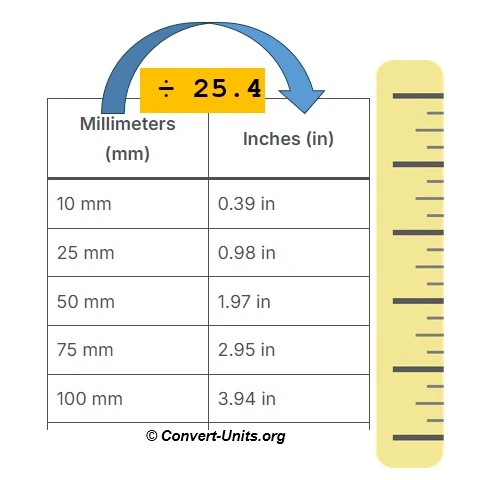
mm to in Conversion Calculator
Click on the following link if you want to convert inches to millimeters – in to mm
History
The millimeter (mm) is a key part of the metric system, created to simplify scientific and everyday measurements using powers of ten.
The inch (in), rooted in older measuring traditions, became standard in the English-speaking world centuries ago.
In 1959, both systems were aligned internationally, fixing 1 inch = 25.4 mm. This made conversions between the two systems completely precise and globally consistent.
Common Usage
- Millimeters (mm) are used in engineering, architecture, design, and manufacturing.
- Inches (in) are used mostly in the U.S., UK, and Canada, for measuring body height, screen sizes, and construction materials.
For example, a smartphone that is 75 mm wide measures about 2.95 inches.
Millimeters to Inches Conversion Formula
The conversion is simple and exact:
in = mm ÷ 25.4
Example:
Convert 100 mm to inches.
100 ÷ 25.4 = 3.94 in
So, 100 millimeters equal 3.94 inches.
Conversion Table
| Millimeters (mm) | Inches (in) |
|---|---|
| 10 mm | 0.39 in |
| 25 mm | 0.98 in |
| 50 mm | 1.97 in |
| 75 mm | 2.95 in |
| 100 mm | 3.94 in |
| 150 mm | 5.91 in |
| 200 mm | 7.87 in |
| 250 mm | 9.84 in |
| 300 mm | 11.81 in |
| 500 mm | 19.69 in |
Fun Facts
- The inch is still dominant in display and tire sizing, even in metric countries.
- A standard credit card is 85.6 mm wide, or about 3.37 inches.
- The average smartphone width is about 70–80 mm, which equals roughly 2.8–3.1 inches.
Frequently Asked Questions
1. How many inches are in 100 mm?
3.94 inches.
2. How do I convert mm to inches quickly?
Divide by 25.4, or roughly divide by 25 for a close mental estimate.
3. Why are inches still used in technology?
Because screen and display sizes were standardized in inches decades ago.
4. How many millimeters are in 1 inch?
Exactly 25.4 mm.
5. Is 1 inch bigger than 1 mm?
Yes, much bigger — 1 inch equals 25.4 mm.



